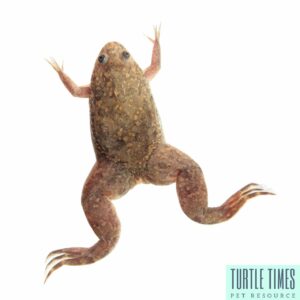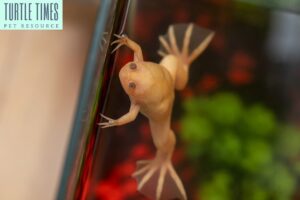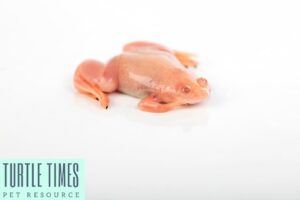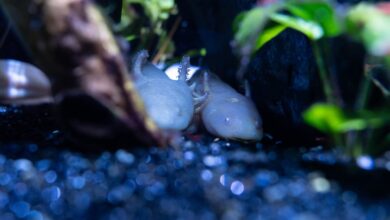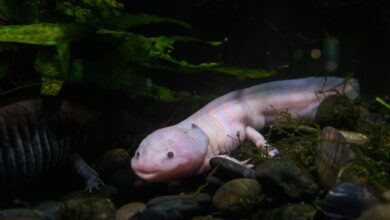The Upland Clawed Frog – Xenopus Laevis
Facts About The Upland Clawed Frog – Xenopus Laevis
Family Pipidae
The family Pipidae represents a group of freshwater, aquatic frogs. There are five living genera – four living in Africa,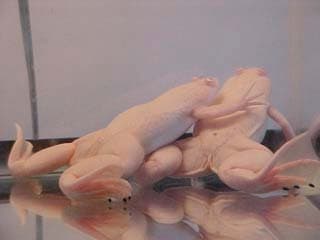
- Hymenochirus (4 species)
- Pipa (7 species)
- Pseudhymenochirus (1 species)
- Silurana (2 species)
- Xenopus (15 species)
Fossil Record
The family originated around 125 million years ago, during the Cretaceous. During this era, Africa and South America were still connected, flowering plants began to evolve, and the dinosaurs reached their greatest diversity. The earliest pipid fossil found was in the Negev Desert in Israel. It dates back to the Early Cretaceous period. During this time, the Negev was part of the African continental plate and Africa and South America were still connected. Xenopus first occurred in Niger during the Late Cretaceous. A frog in the genus Eoxenopoides, came on the scene in southwestern Africa at the beginning of the Tertiary (65 million years ago).
It was a very close relative to Xenopus. By the Miocene, the range of Xenopus stretched from northern Africa to southwestern Africa. At that time, the climate was universally warm and humid. As the African continent moved northward, the range of Xenopus was restricted because hot, arid conditions developed in the north forcing the frogs to move south of the Sahara. The fossil record of the pipids of South America is not so clear.
An interesting case may be made by comparing the extinct South American Xenopus romeri with the living African X. (Silurana) tropicalis. Scientists have concluded that X. romeri differs from all other species of Xenopus except X. tropicalis. The close resemblance of these two species and other examples indicate that Xenopus diversity was occurring before the continents were separated. By the end of the Cretaceous, the continents were drifting too far apart for any east-west migration by frogs. [Estes, Richard, Herpetologica 31:3 (Sep 1975), 263-278]
Genus Xenopus (meaning “strange foot”)
There are 15 species in the Xenopus genus. They are aquatic frogs with long unwebbed fingers, and fully webbed feet with small claws on three toes. The body is flattened with lidless eyes on top of the head, and they have no tongue. The fingers are used to direct food towards the mouth. Like fish, these frogs have a lateral line sensory system running from head to vent. Under normal circumstances, Xenopus frogs never leave the water, although they have occasionally they have been known to migrate if their home pond dries up. These frogs are well suited for aquatic life, able to swim in all directions, including backwards, with ease. They are air-breathing and depend on well developed lungs.
Xenopus Checklist
| X. (Silurana) tropicalis | X. clivii |
| X. (Silurana) epitropicalis | X. fraseri |
| X. laevis laevis | X. pygmaeus |
| X. l. petersi | X. amieti |
| X. l. poweri | X. andrei |
| X. l. victorianus | X. boumbaensis |
| X. l. bunyoniensis | X. ruwenzoriensis |
| X. l. sudanensis | X. gilli |
| X. largeni | X. vestitus |
| X. muelleri | X. wittei |
| X. borealis | X. longipes |
Upland Clawed Frog General Description
Upland Clawed Frog Range
These medium sized (4-5″) clawed frogs are found in veldt (grassland) ponds and lakes in arid and semiarid regions across most of southern Africa. Two species of clawed frogs, the Upland Clawed frog (X. laevis) and Mueller’s clawed frog (X. muelleri), occur along the western boundary of the Great African Rift. In South Africa, they are known as plathhander or platanna, meaning “flat hands”.
Upland Clawed Frog General Appearance
They have a flat body, a head smaller than their body, eyes on top of their head, and the eyes are small, round and lacking eyelids. Front limbs are small and unwebbed with their four fingers sticking out stiffly from the body. Hind legs are large, webbed, and the inner toes (I, II, III) are tipped with small claws; toes IV and V have none.
Upland Clawed Frog Color Pattern
Xenopus are multicolored, with their backs in various shades of olive gray with large gray blotches. Their bellies are creamy white, with creamy white toes and legs; a yellow tinge may be present.
Other Body Features
There is no visible tympanum (ear); their skin is smooth with a stitched appearance (lateral line); males lack cloacal flaps. Males develop darkened “nuptial pads” on inner forearms and fingers during mating season.
Upland Clawed Frog Calls
Both the males and females call from underwater. Despite the fact males have no vocal sacs, they can be heard at distances of 100 yards. The call is a metallic clicking sound lasting about 1/2 second, uttered at a rate of 100 per minute.
Upland Clawed Frog Reproduction
Breeding among frogs in the genus Xenopus contains both primitive and highly specialized elements. Amplexus (mating embrace) is pelvic or inguinal. This is where the male grasps the female with his forearms just above her hind legs. More advanced frogs use axillary amplexus (male grasps the female near her front limbs). While embraced, both frogs will perform a series of somersaults, the eggs released and fertilized while in the upside down position just under the water surface. They will then right themselves as they approach the pond bottom and repeat the circular motion until all eggs are expelled. The eggs are about 1 mm in diameter and encased in a gelatinous capsule. Several thousand eggs can be laid by a single female. The eggs are scattered over the area, and are unprotected. Eggs hatch in about a week. The tadpoles, which have catfish-like whiskers, congregate in a head down position, sucking protozoa into their mouths rather than scraping algae like most other species. They metamorphose in 40 days. Adults eat practically anything that moves and will fit into its mouth. They reach sexual maturity in 10 months and can live 10-15 years.
Upland Clawed Frog Man and Xenopus
For many years, clawed frogs have been used as a laboratory animal, and in studies of vertebrate embryology. They were brought to the U.S. in the 1940s and used to diagnose pregnancy: the female frogs began to lay eggs when injected with the urine of a pregnant woman. These frogs were very inexpensive and easy to keep. Since more modern methods of pregnancy testing has been developed, thousands of clawed frogs have been released and have firmly established themselves in the streams and ponds of the American southwest where they are a threat to native frogs. The importation or possession of clawed frogs is now illegal in many western states. However, this aquatic species remains popular elsewhere as an aquarium pet.
Sources
- Cochran, Doris, Living Amphibians of the World, Doubleday (New York): 1961
- Deuchar, Elizabeth, Xenopus: The South African Clawed Frog, John Wiley (London): 1975
- Stewart, Margaret, Amphibians of Malawi, SUNY Press (Albany): 1967
- Webb/Wallwork/Elgood, Guide to Living Amphibians, MacMillan Press (London): 1981
- Tinsley/Kobel, The Biology of Xenopus, Oxford University Press (New York): 1996

